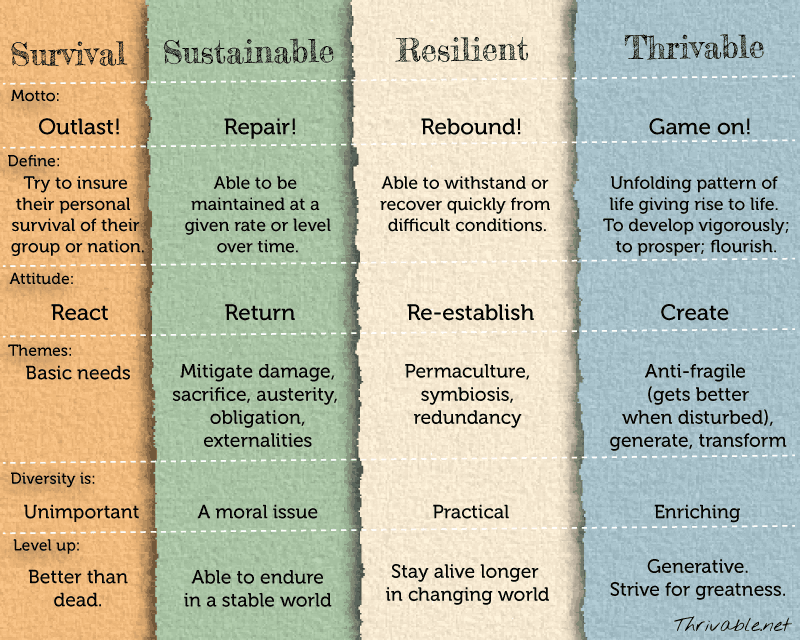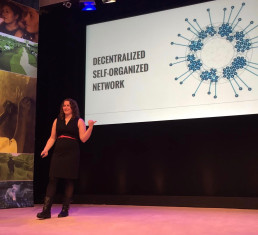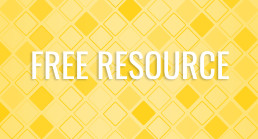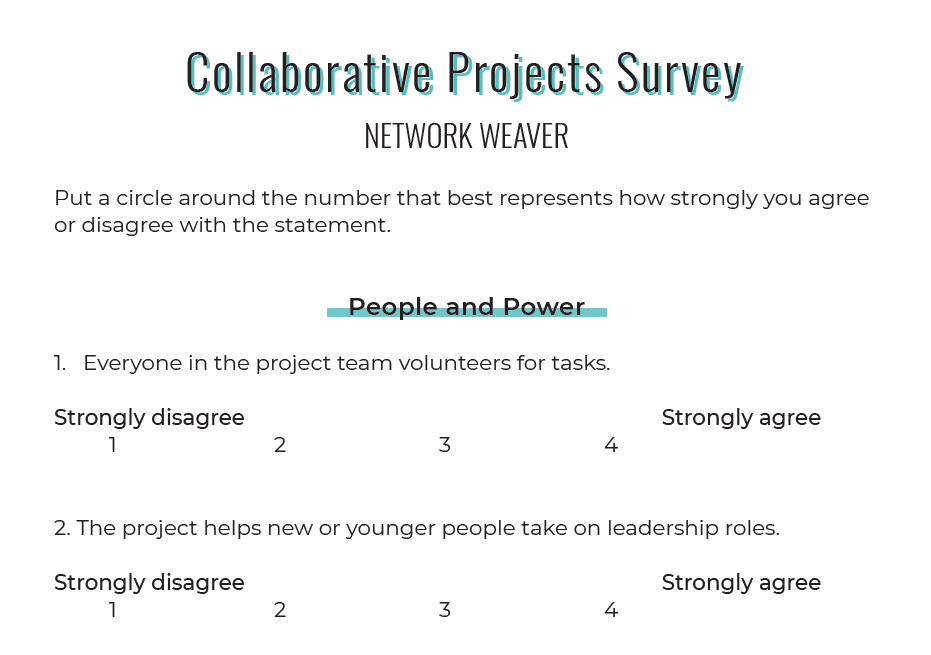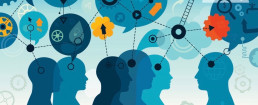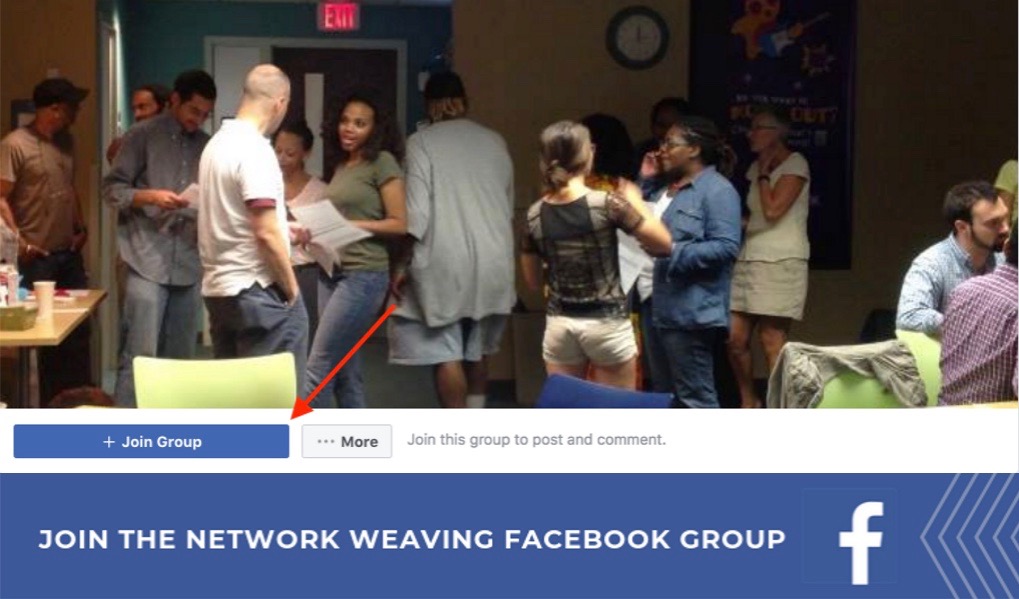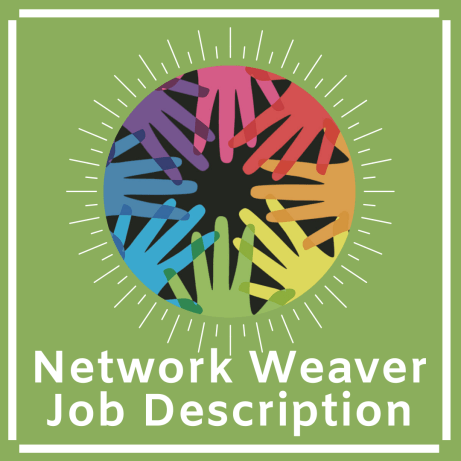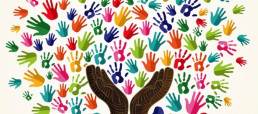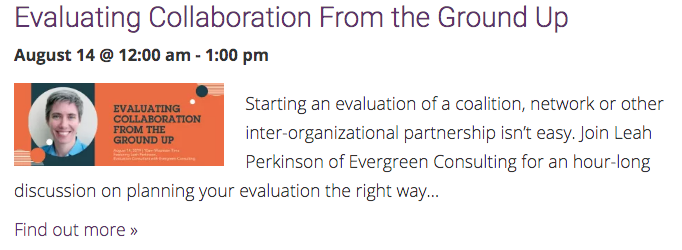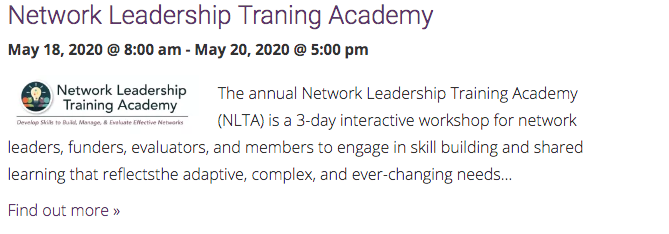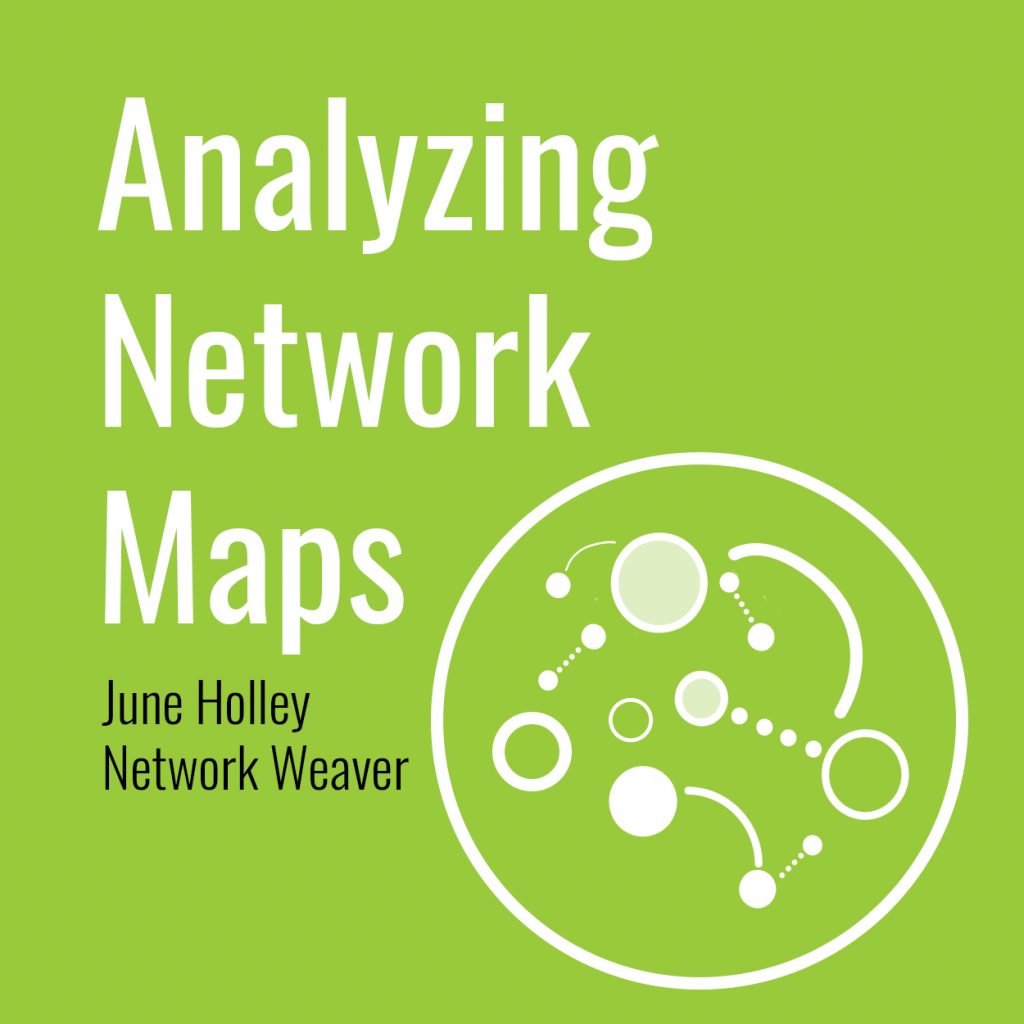Organizations as Communities
November 5, 2019Network Processes,Blog
[ap_spacing spacing_height="15px"]
* * *
Many people have asked how their network can function when organizations remain in their traditional hierarchical structures. Sahana's post explains how organizations, especially those in networks, need to shift and change. - June
* * *
Part 1
Designing orgs as communities make for responsive, thrivable organizations
[ap_spacing spacing_height="10px"]

[ap_spacing spacing_height="10px"]
The very definition of organizations has changed. The impact of digitization is going far beyond a few collaboration tools and platforms. Today’s organizations are no longer defined by fixed workplaces, nine-to-five working hours or even a set of homogeneous employees. Organizations have become boundary-less and often, location agnostic and virtual. Operational and business models have been turned on their heads with the advent of enterprises like Uber, Airbnb, Etsy and Amazon. And no industry is immune to this disruption — from education to retail, from healthcare to hospitality — the old business models are being rapidly upended by new ones. We have entered the Black Swan era with un-directed and unpredictable events regularly cropping up. These complexities are continuing to exponentially increase as we enter a hyper-digital era with AI, Robotics, 3D printing, Wearables, Alternate Reality and VR, and much more looming over the horizon. Some of the key shifts were identified by Dr. Lynda Gratton in her book, The Shift, and are depicted in the diagram below:
[ap_spacing spacing_height="10px"]

[ap_spacing spacing_height="10px"]
These paradigm shifts are causing wide-scale disruption in our personal and professional lives, and reflect an urgent need to rethink and re-imagine the workplace in order to take advantage of the affordances offered by the digital era. This is not merely about implementing a few collaboration tools or putting in place an Enterprise Social Network (ESN) with the diktat to “collaborate”. It requires a complete re-hauling of how business gets done. Organizations have to leverage the power of design thinking and emergent technology to create spaces where everyone can bring in their fullest potential. Going ahead, organizations of the future will possibly function as Transformative Communities connecting diverse, distributed and multi-talented individuals who will come together to move toward an Evolutionary Purpose.I will write more about the evolutionary purpose and transformative communities in my future posts.
The need for organizations to function as communities of passionate and purpose-driven individuals is becoming even more critical in the face of unprecedented upheaval being faced at local, global and planetary levels. Top down, hierarchical, command and control organizations just do not have the agility or the resilience to meet the needs of today. As the world becomes increasingly connected and networked, it calls for organizations that are equally networked and decentralized. An organization’s communities today would not be restricted to its internal employees but would extend to include contractual and contingent workers, partners, vendors and suppliers, and also customers and competitors — the extended enterprise. I would also add the Planet and all sentient beings since every decision taken has a ripple effect with the capacity to impact millions far away from the origin of the organization. For example, the massive expansion of palm oil plantations in Borneo and Sumatra are directly threatening the survival of orangutan population in the wild. We are all well versed with the Butterfly Effect. Hence, this “extended enterprise” is as critical to the sustainability — nay, the Thrivability — of the business as any direct employee/shareholder. It’s no longer enough to build an organizing that survives or is even just sustainable. The former implies a closed view/self-focus and the latter implies an organization that is just maintaining itself. A thrivable organization is anti-fragile, holds space for emergence and creates opportunities for the thriving of others, and flows with the change.Perhaps it is time for organizations to pause and ask:
How can an organization be designed such that it becomes a space that nurtures, supports and enables conditions of thriving?
The diagram below created by Jean Russell highlights the differences...
[ap_spacing spacing_height="10px"]
[ap_spacing spacing_height="10px"]
A lack of Systems Thinking and understanding of Complex Adaptive Systems coupled with the desire/pressure for limitless growth have led organizations toward the kind of tunnel vision which has collectively led us to a place no one wanted to reach. I am emphasizing on organizations becoming communities because communities allow us to tap into Collective Intelligence from a diverse pool of people without the constraint of hierarchy, permission and rigidity. To be an evolutionary and purpose-driven organization and to engage in situations we do not have a roadmap for, it is important to seek/curate collective intelligence.
However, the underlying business processes, managerial strategies, and workplace protocols still adhere to mechanistic, Industrial Era paradigms with performance, speed and bottom line being the drivers. These, needless to say, lead to short term thinking, repeating of past patterns, loss of innovation, frustration and burnout, and a joyless work environment. By sticking to Industrial Era processes when that era is long gone, organizations threaten their own survival. Viewing an organization through the lens of a machine and people as cogs worked when the world was predictable, change happened very slowly, lessons of yesterday became best practices of today, and assembly line production ruled the day. Gone is that era. The 90’s brought the term VUCA into our consciousness. And the last decade has seen a veritable tsunami of change. Technology is taking us to a world that is science-fiction-like in its possibilities. But everything will come to naught if the patterns, mindsets and underlying consciousness guiding us continue to remain static. Our organizations today are rooted in the past while the future is already here. Unless we are cautious, we will run the risk of using technology to amplify and empower old systems and processes (faster production, greater efficiency, higher bottom line) while the organization gradually becomes less human, and we come face-to-face with our own Frankenstein. As we lose our humanity to the glitzy appeal of speed and technology, so will we lose our interconnectedness with each other and all sentient beings.
The power of technology is immense. The choice is ours — whether we use it to amplify our humanity and connectedness to each other and the planet or we use it to further short-term profits at the cost of humanity and all sentient beings.
Never in the past have we had such unprecedented opportunities to connect thousands, millions of people together. Never in the past did an organization have the platforms and technology necessary to build communities of passionate, diverse, globally dispersed and differently skilled individuals. Organizations now have the power to move from building teams to enabling evolutionary co-creating communities.
My next post will focus on how to move towards building communities, overcome obstacles and envision what such a re-imagined workplace could look like.
[ap_spacing spacing_height="20px"]
Part 2
Exploring how communities enable sensemaking and emergence in organizations
Yesterday, in a Twitter conversation with Rachel Happe regarding the need for organizations to function as communities, I wrote the following: “Complicated solutions are yesterday’s good practices. Complex, holistic solutions are multi-faceted, emergent and constantly evolving. They can’t be pinned down by rules but have to be sensed into through open dialogues.”
This reminded me of one of my favorite frameworks — the Cynefin framework designed by Dave Snowden in 1999. Cynefin is a Welsh word meaning habitat; the framework is simple and elegant but leads us to profound insights. If we see the framework below, we can easily see where we are today as humanity and where we are headed. The habitat for organizations has moved from being complicated to complex with exponentially increasing rate of change (Moore’s Law in action) and is rapidly heading towards the chaotic. As is evident, rules, processes, constraints and good practices worked perfectly for the complicated, mechanistic Industrial Era. However, complexity requires Systems Thinking and “enabling constraints”. I interpret enabling constraints as “holding space for emergence” where constraints function as a safety net.
[ap_spacing spacing_height="10px"]
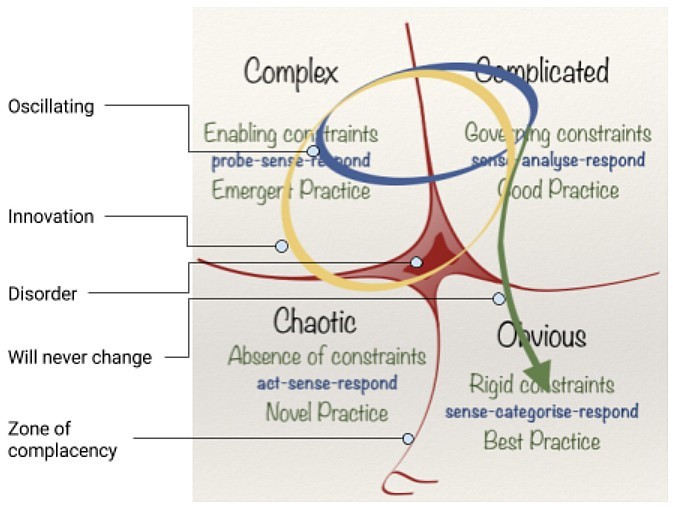
[ap_spacing spacing_height="10px"]
This is where things get tricky. Leaders today are geared to respond to challenges with speed and action. The hierarchical structure of most organizations places a few people at the top charged with all critical decision-making, thus losing out on the vast capacity of the collective intelligence available throughout the organization. And, ironically, in the face of increasing complexity and uncertainty, there is more pressure to deliver “results” and “do something” to allay the situation. What of course ends up happening is the putting of band-aids over symptoms while the root causes go un-examined, unexplored, and left to proliferate. While it is counter-intuitive, complexity requires us to slow down— to probe, sense, and then respond. It requires us to go from rapid-fire action to observation, reflection, and thoughtful response when the time is right.
How are communities connected to complexity, collective intelligence and “sensemaking”?
I propose that in the context of pervasive complexity and ambiguity, communities of passionate, connected and purpose-driven individuals can illuminate the way forward. Communities are different from typical project teams who come together for an explicit outcome, work towards their objectives, and when the work is done, it’s done. I am not denying the value of great team work having been a part of some amazing teams myself. However, I am focusing on communities here because communities come together and cohere very differently. They are usually aligned around a purpose larger than each individual; membership is usually voluntary which means people go where they are drawn to go. Diverse people connect who may “normally” not have known each other, creating greater opportunities for serendipity and innovation. Communities allow lurkers to also exist within its ecosystem, something teams cannot do. I believe lurkers carry immense value as they often become channels of cross-pollination between communities and are a critical part of the weak-tie network making a community more diverse, resilient and porous. And most importantly, communities carry a sense of belonging to something beyond the self. All of these contribute to make communities adept at feeling into the ecosystem, seeing the system through different lenses, caring about the system, and responding to the emergent with deeper insight. This is what tapping into the power of collective intelligence is about.
[ap_spacing spacing_height="10px"]

[ap_spacing spacing_height="10px"]
Therefore, when an organization functions as a collective of networked communities, its ability to probe and sense its ecosystem increases manifold. It is akin to a human using all our five senses as well as the heart and the gut as opposed to only our rational ability. In the diagram below, I have tried to represent an organization as an open system connected via today’s ubiquitous technology. Imagine an organization whose boundaries are porous, giving it the capacity to fluidly exchange information with its ecosystem. Internally, the organization functions as clusters of communities which also have porous, permeable walls. The community members interact and connect through various means (some of which are shown in the diagram). This creates a system that is able to constantly sense and see itself, can connect its edges to its center and hold complexity by distributing it in the network.This ability to tap into the collective intelligence and wisdom of the whole makes a system/organization resilient, anti-fragile, and eventually thrivable. This requires viewing the organization as a living system that has the capacity to adapt, heal itself, and thrive given the right conditions.
I admit though that this is easier said than done. I have written about some of the obstacles to building communities here. Apart from the technology and the roles of community facilitators, this shift requires re-imagining and reinventing the structures, processes, and the culture as well as the underlying narratives of an organization. All of this are the glue that hold the fabric of the organization together in its current state, and exert powerful resistance to anything that threatens the status quo. I am not saying the shift is easy at all. However, as global trends and patterns threaten to plunge us into chaos, it is time to rethink and re-imagine our organizations. It requires us to move from holding a few leaders at the top accountable and responsible for all decision, actions, and their intended and unintended consequences. We are well aware that complexity cannot be tackled through planning, controlling, resource management, and other known and popularized forms of management and leadership. Complexity calls for leaders to become facilitators, to hold space, to flow with uncertainty, to let leadership emerge from the collective, and to be able to sense the system. Leadership’s role becomes that of designing and holding the container for exploration and the emergence of future potential. All of these capacities come not only from experience but also from deep reflection and inner work. In the section below, I have discussed — what I believe — are some of the mindsets/capacities required of the leaders if they wish to design for thrivability.
[ap_spacing spacing_height="10px"]

[ap_spacing spacing_height="10px"]
- Holding space for Emergence — This involves creating the conditions and preparing the soil (the ethos/culture) for dialogues to take place. This requires the capacity to be comfortable with the discomfort of staying in the liminal space, and not forcing a pre-defined outcome when a problem rises to the surface. It’s also the ability to see problems as gifts/messages calling the organization’s attention to what needs to shift. And using processes like The Circle Way, the U Process, and Liberating Structures to have generative conversations. [ap_spacing spacing_height="10px"]
- Staying with Uncertainty — While close to the above capacity, I have deliberately called it out separately as well. Leaders have the propensity and are often expected to provide answers in times of great uncertainty and upheaval. Staying with uncertainty conversely requires leaders to strengthen their muscles for staying in the space between stories, suspending judgement, being ok with not having any answer, and tapping into one’s inner guidance till a response naturally surfaces. And as leaders develop and operate from these capacities within themselves, the core skills permeate throughput the organization with support. [ap_spacing spacing_height="10px"]
- Creating space for Synchronicity — In the rush of solving daily challenges and focusing on short term goals, we all forget to slow down and stay with the emerging. Welcoming synchronicity require us to hold space for ourselves as well as others, to tap into our inner wisdom and allow the unfolding to happen. I can best describe it as a shift from doing to being. It’s in the in-between space when we let go of control and trust in a higher order do we begin to experience the synchronicity that come our way as guideposts.[ap_spacing spacing_height="10px"]
- Operating from Inter-connectedness — I firmly believe in the concept of “Interbeing” described by Thich Nhat Hanh. His definition of “seeing clouds in a piece of paper” is the quintessential and an eloquent description of Systems Thinking. It is essential for leaders to operate from this space of inter-connectedness and the whole lest the fixing of a problem in one part of the system creates unintended consequences in another part, and maybe elsewhere in the ecosystem too.[ap_spacing spacing_height="10px"]
- Sacrificing an Expert’s Mindset — Most of us are aware of the Japanese concept of shoshin articulated by Shunryu Suzuki as, “In a beginner’s mind there are many possibilities, in an expert’s mind very few.” One of the fundamental capacities for holding space is to let go of the expert’s mindset, and also one of the most difficult. It means a letting go of the ego and all other credentials that has brought us to our current state of power, position, and privilege. This letting go is essential to foster openness. An expert’s mind will not be able to create space for emergence.[ap_spacing spacing_height="10px"]
- Facilitating Generative Conversations — I strongly recommend going through and practicing the four levels of listening and conversing defined by Otto Scharmer in his book, The Essentials of Theory U. A capacity and willingness to move beyond the downloading and factual to empathic and generative is essential to bring collective intelligence and creativity in the service of a greater good. In the first two situations, no new learning or insight can emerge as we stay stuck in false harmony or debate/compromise, respectively. They only serve to keep the system stuck in the old patterns and habits. The next two — empathic and generative listening — open up the field of the future and lead to emergent practices. I have included the diagram below for reference.
As would have occurred to most of you’ll reading the post, the capacities mentioned above require not only deep reflection and inner work but also great empathy, curiosity, courage, and compassion. Only by holding ourselves and others with open compassion and acceptance can we even begin to create the conditions for thrivability. I’ll deep dive into these aspects in future posts.
The next questions are: “Despite the phenomenal capacities of technology today, is technology the only solution? How important are connections in person? How critical is it for us to experience our inter-connectedness with nature? How do we balance the virtual world with the real world we inhabit?”
I’ll explore these questions in my next post. You can read the Part 1 of Organizations as Communities here.
[ap_spacing spacing_height="10px"]
Part 1 originally published on Sahana Chattopadhyay's Medium page HERE
Part 2 originally published on Sahana Chattopadhyay's Medium page HERE
Navigating Uncertainty to Gain the Real Value of Collaboration
October 22, 2019Network mapping,Network Weaving,Blog
PART 1
Investing in Collaboration
[ap_spacing spacing_height="5px"]
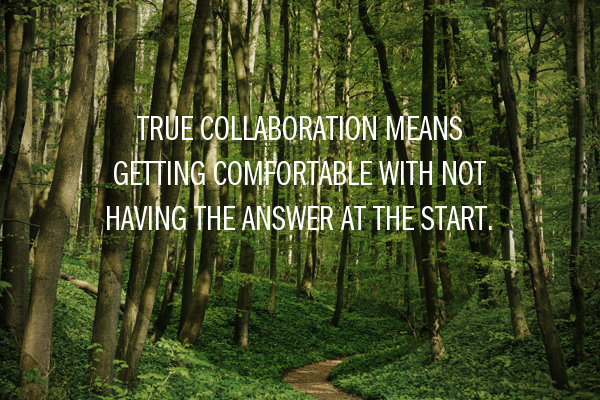
A client recently called us her “network therapists.” She works for a foundation and was helping launch a network. The foundation saw that if organizations in a region could work in a networked way they could achieve greater impact and have a stronger political voice. However, the organizations had to find the value in working together – it had to come from them – or the network would not work. Our client experienced the discomfort of wanting a concrete plan and answers while we were in the stage of creating the space for the participants to come to those answers together. Investing in true collaboration meant we asked the question of the group, and had to be open to what their answer was, even if they concluded they did not see value in creating a network.
In a similar example, the Executive Director of an environmental non-profit asked for our help in bringing together many organizations working on a specific environmental problem to align their work and create a network. He recently said to me, “What I really want is to get everyone invested and agreed on the direction we are heading, and on a plan.” If you want to arrive at a shared vision and a plan that integrates and builds on the breadth and depth of expertise and perspectives of the group, it has to be developed together. The challenge is that in order to get to that, there is a time early on where you have to bring everyone together without a clear vision or clear plan.
But wow, is this territory uncomfortable for people! Another client said “this really is a leap of faith.” Indeed. A key part of my job is guiding leaders of collaborative initiatives in how to navigate this unfamiliar territory of uncertainty. It’s a process of learning through experience that, as my friend Adam Pattantyus says, “the unknown can be trustworthy.”
In Part 2, below, we explore why the real prizes to be gained from collaboration may lie beyond our comfort zone.
[ap_spacing spacing_height="20px"]
PART 2
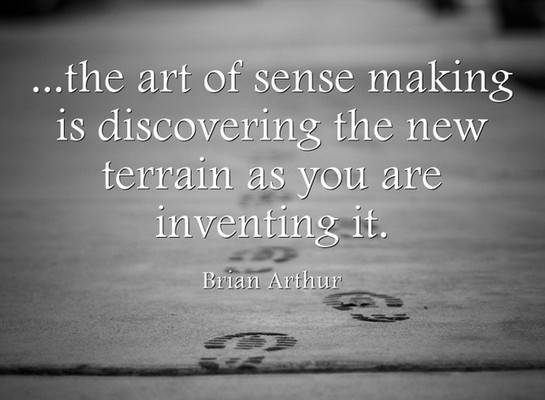
For collaboration to work, one has to be willing to enter uncomfortable territory of not having the answer. People can feel it when they are asked to collaborate but the plans and answers are already determined. It feels quite different when instead of pushing an idea or agenda on the group, there is a mutual discovery and potential for something new to emerge. Real collaboration enables us to develop ideas and solutions that could only emerge from this combination of people thinking and working together.
Showing up without an answer means you have to ‘unlearn’ things you have been trained to do and have worked well for you. Consider the following roles that leaders play and the skills needed:
- To lead an organization, you need to have a strategy, goals and plans.[ap_spacing spacing_height="10px"]
- To be an environmental or social advocate, you build a case and persuade people and those in power to adopt your position.[ap_spacing spacing_height="10px"]
- To be a good sales person or fundraiser means pitching an idea or proposal and getting others to buy or fund it.[ap_spacing spacing_height="10px"]
- To manage a project, you want to have clear goals, time lines, roles, etc. and be able to report on those to a boss or funder.
Most leaders have learned the skills to have the answers, make a case, and pitch it to gain support, funding, resources, etc. These skills are valuable; however, when in the early stages of developing a collaboration, leaders need to focus on finding the right questions and on listening and making sense of what they are learning together. The tendency to promote the answer that comes from “me” before taking the time to discover the answer that comes from “we” can undermine the full potential of a collaboration from being realized.
Another way traditional leadership skills come up short is when we are working to develop innovative solutions to complex problems. The challenges we face are enormous and interrelated, and in many cases have not been encountered before. For these kinds of “wicked problems,” there is not a simple obvious answer; there is no playbook or recipe for how to solve them. Climate change is an example of a wicked problem, e.g., it has multiple causes and disparate ideas on how to address it, it involves finding ways to motivate people to adopt different behaviors, and humanity has not faced this pace and scale of change before.
In situations like these, we need to explore into the unknown. We need to make sense of the landscape and needs, drawing on as many perspectives as we can, and then create and try various actions, learning and reflecting as we go.
Great leaders are identified by their ability to perceive the nature of the game and the rules by which it is played as they are playing it. In other words, the art of sense making is discovering the new terrain as you are inventing it. – Brian Arthur
This brings us back to the need for leaders to unlearn skills that have worked well and learn and practice new skills. The need for this new skill set and orientation is being recognized in many places and is being called by many names: collaborative leadership, participatory leadership, adaptive leadership, network leadership, leading for regeneration, leading through complexity. A core element in all of these is learning to access the wisdom of larger groups in uncertain territory. In part 3, below, we explore tips for how to navigate this territory.
[ap_spacing spacing_height="20px"]
PART 3
Tips For Navigating Uncertain Territory

Here are some of the ways I coach leaders in learning how to work in this uncomfortable territory of not having a clear answer or plan:
- Name the discomfort – I find it helps to name how uncomfortable this feels, e.g., to convene a group without a plan. Showing this graphic to the left brings some humor to it. I invite people to give it a try. [ap_spacing spacing_height="10px"]
- See it as ‘iterative design’ – The nature of this work is to design things with the group each step of the way and accept that we do not know where it is headed. I assure people if they can trust the group and give them the space to arrive at the answers together, there will be a much greater level of buy-in and commitment. We will get to clear answer(s) each step of the way and it is helpful to record, illustrate, and share back what has been decided regularly.[ap_spacing spacing_height="10px"]
- Frame strategic questions – Instead of coming up with answers, the focus is on coming up with questions. The role of the leader is to sense and clarify the context and distill what is needed into a strategic question, or series of these, for the group to answer. I imagine this as standing on the edge of the known and unknown, and asking a question that can bring clarity to the next step. This blog about Setting the Table for a Great Meeting offers a process for this.[ap_spacing spacing_height="10px"]
- Appreciate the value of the mystery – I have come to realize that the mystery of “not knowing” is the source of vitality, aliveness, and creativity. This kind of space is what draws people in. Think about watching a movie or reading a mystery novel, you are curious about what will happen next, you are drawn into to discover the clues, it is fun and entertaining. Likewise with a group, when you design an initiative or meeting by framing powerful questions that the group will jointly find answers for, this generates interest. And, when answers emerge together, which had not been clear at the start, it builds confidence in the value of this way of working.[ap_spacing spacing_height="10px"]
- Cultivate patience – This takes some inner work on the part of leaders to “let go” of those conditioned tendencies of urgency, need for action, micromanaging, command and control, deliverables, outcomes, and rush. This impatient energy of “what are we going to DO?” can undermine and shortcut the value of collaboration. A coach or colleague can point out when leaders fall back into traditional ways of rushing to an answer and action too soon.[ap_spacing spacing_height="10px"]
- Meditate – I have found that a regular practice of meditation has been valuable in learning to be comfortable in this state of “not knowing.” In Comfortable with Uncertainty, the Buddhist teacher, Pema Chodron, articulates the challenges of this territory and shares practices to hone our capacity to work in this space. The aim is to focus our attention in the present moment, and notice where our thoughts take us into planning, thinking, and figuring out. When you notice, you let them go, and repeat and repeat. With practice, it gets easier to be okay with where things are at this moment and the urge to plan and control lessens.[ap_spacing spacing_height="10px"]
- Orient people to working in this different way – There are various ways to frame how a leader can show up, such as:
- Invite people to help find answers together versus see people as someone to pitch or convince to get on board with your idea
- Give space for ideas to emerge and take shape versus debate what we already know and ideas we already have
- Make sense of a changing situation together versus assume we know the answer
- Inquire, learn, and experiment as a scientist or inventor might versus operate in a command and control mode of implementation like a military leader or project manager
- Realize that the path will only become clear as we walk it (and it will likely not be linear) versus following a pre-existing route on a map
- See conversations and learning together (i.e., that weave relationships and connections to create a rich web of networked collaborations) is itself action versus only see outcomes as things that are visible or in an action plan.
For further learning in this area, I recommend reading about the Chaordic Path or Chaordic Stepping Stones, which is a process used in Art of Hosting. This quote from Kathy Jourdain of Shape Shift Strategies sums it up well:
“’At the edge of chaos’ is where life innovates — where things are not hard wired, but are flexible enough for new connections and solutions to occur. To lead teams, organizations and communities on the chaordic path, leaders need “chaordic confidence,” to have the courage to stay in the dance of order and chaos long enough to support generative emergence that allows new, collective intelligence and wiser action to occur.”
Originally Published at New Directions Collaborative
Tamara Shapiro
Tamara Shapiro was a lead strategist and facilitator of the InterOccupy network which facilitated democratic, interactive conference calls that led to regional and national actions, conferences and multi-city events. She was one of the lead coordinators of Occupy Sandy, the most effective citizen-led relief effort in U.S. history.
Collaborative Projects
September 20, 2019Reflection and Learning,Blog
This Collaborative Projects Survey can be used to help collaborative work or learning projects increase their awareness of their strengths and challenges and enable them to see the skills that need to be built by the group.
The free resource includes a “hard copy” of the Collaborative Projects survey that can be printed out and handed out to people at project meetings. It also includes an instruction sheet which includes a web-based version of the survey that people can take during a meeting on their smartphones or the link can be provided during a virtual meeting for people to take and immediately see the results.
I highly recommend the web-based version as it enables the participants to immediately see the results for the entire group.
Let us know if you use the survey, any suggestions for changes and improvements, and whether your group found it useful.
Download the survey HERE.
Creating a movement of people connecting people for systems change
We are now reaching 10,000 people directly through our weekly newsletter, June's LinkedIn and Twitter accounts, and the Network Weaving Facebook group. That's great news!
But many many more people around the world could benefit by hearing about network weaving so that we create a movement of people connecting people for systems change.
[ap_spacing spacing_height="20px"]
Here are a few things you can do:
1) Could you take a minute to share this newsletter to one or two of your friends? [ap_spacing spacing_height="10px"]
2) If you aren't already could you follow June on twitter and then retweet any of her posts? Also tweet a message encouraging your followers to follow June to get tweets on network weaving. Feel free to post this image:
[ap_spacing spacing_height="35px"]
3) Follow June on LinkedIn - this way you will also receive messages from June's scoop.it on what people are writing about networks, network leadership, self-organizing and reflection and learning.
[ap_spacing spacing_height="35px"]
4) Join the Network Weaving Facebook Group and invite your friends
[ap_spacing spacing_height="20px"]
Thanks for considering these steps!
Feature image from The Engineer
Network Weaver Job Description
August 9, 2019Network Weaving,Blog,Network Leadership
[ap_spacing spacing_height="10px"]
Many networks are hiring network weavers and/or network coordinators or managers. I pulled together two excellent examples of job descriptions, which are detailed below. You can also access them through the resource page as a free resource so you can email them to your board or hiring committee.
[ap_spacing spacing_height="40px"]
Below is a network weaver job description from a network I’m working with, the Resonance Network. What would you add or change?
[ap_spacing spacing_height="15px"]
[ap_spacing spacing_height="20px"]
Network Weaver
[ap_spacing spacing_height="20px"]
Core Responsibilities
- Develop a plan to align and weave the various parts of the Network – individuals, collectives, communities, projects and actions -- routinely connecting parts and people across groups and projects
- Catalyze and coordinate network-wide activities in alignment with current strategic priorities
- Support all staff, consultants and network participants to have a basic understanding of network approaches, network values and basic network weaving skills
- Facilitate integration of network weaving perspective and practice throughout network activities
- Coordinate pool of network facilitators -- connecting them to collaborative and/or self-organized projects seeking their support and organizing them into a community of practice
- Design and implement engagement ladders, providing a spectrum of opportunities for network participants to get involved in network activities
- Catalyze and support self-organizing among network participants
- Use network maps to identify opportunities for connections among individuals and projects to better connect the network
[ap_spacing spacing_height="20px"]
Desired Qualities/Experience/Skills
- Experience in building and nurturing networks, coalitions, or communities of practice that encompass a range of perspectives, cultures, and backgrounds, including experience growing online/offline community through art, mobilization, and/or organizing
- Proficiency in network mapping tools and analysis of maps
- Comfortable working in a quick-paced environment to help develop the weavers and facilitators to support network development.
- Open to experimentation, learning, and adjustments along the way; ability to push through ambiguity to deliver results
- Deep passion for building and supporting relationships; skilled in lifting up the work of others, often in a behind-the-scenes way
- Strong project-management skills including great attention to detail, organizational skills, and the ability to manage projects with many moving parts
- Superb written and verbal communication skills
- Comfortable flying in the cloud (Google Drive, Slack, Salesforce, Dropbox, etc.), and proficiency with or willingness to learn Kumu or other network-mapping tools
- Ability to work independently and think creatively about how to leverage the resources at your disposal
- Strong interpersonal skills, including ability to communicate openly and directly with co-workers and community members
- Demonstrated commitment to racial, social, and economic justice
- People of color, immigrants, queer, women, transgender, non-binary folks encouraged to apply
[ap_spacing spacing_height="45px"]
Below is another description, this time for a Network Manager or Coordinator. From the Santa Cruz Mountains Stewardship Network developed by Converge.
[ap_spacing spacing_height="15px"]
[ap_spacing spacing_height="20px"]
Network Manager
[ap_spacing spacing_height="20px"]
Primary Responsibilities
The Network Manager creates, cultivates, and ensures high quality relationships and collaborations that advance the mission of the network. Primary responsibilities are to:
Convene the Network
- Help design and facilitate network convenings
- Organize convening logistics, including meeting locations, catering, materials, reminders, etc.
Catalyze the Network
- Support new member onboarding
- Facilitate connections between network participants
- Support network participants to more deeply connect their organization with the work of network
Coordinate the Network
- Coordinate and join monthly Core Team & Impact Team meetings and calls, identifying points of intersection and bottlenecks, and helping to connect network participants with other network members or regional leaders for assistance or support
- Track project progress, outcomes, bottlenecks
- Capture key takeaways and next steps from convenings
- Regularly update the network dashboard and provide monthly updates
- Manage network finances and budget
- Perform site visits to stay aware of network projects and stewardship collaborations between participants
- Coordinate with other regional networks to identify points of intersection
- Maintain the network’s technological infrastructure (Basecamp, Google Docs) and keep them up to date
Communicate with and for the Network
- Function as primary point of contact for the network internally and externally
- Connect with each individual participant of the network to understand their work, their organization, how the network can support the participant and their organization in service of shared goals as outlined in the MOU, and how the participant and their organizations can support and more strongly engage with the network
- Keep network conversations vibrant and alive
- Reach out to drifting participants and find creative ways to re-engage them in the network
[ap_spacing spacing_height="15px"]
Resource the Network
- Support and lead network fundraising efforts with the Resource Impact Team and the Core Team
- Work with network members to identify and secure in-kind contributions, including meeting locations, transportation, catering, materials, etc.
[ap_spacing spacing_height="15px"]
Essential Skills
- Strong interpersonal abilities, with a willingness to cross boundaries and work with diverse people
- Solid facilitation and presentation skills
- Exceptional attention to detail, super organized, great time management
- Dynamic problem solving skills
- Comfortable with technology
Personal Characteristics
- Deep passion for the mission
- Personal humility, servant leader, network entrepreneur
- Knows how to ask for and receive help
- Proactive, self-starter, loves to take initiative with an urgency to get the job done
- Understands the big picture and larger context of the work, systems thinker
- Ability to see all sides of an issue
- Patient, stays cool under pressure
- Great sense of humor, ability to see the positive
- Loves nature and the region
Check Out These Network Weaving Events!
August 1, 2019Network Weaving,Blog,Network Leadership
Did you know we have an Events Page? We publish Network Weaving Events hosted by our Network Weaver Consultants and other amazing weavers. Below are some upcoming webinars, meetings and trainings.
[ap_spacing spacing_height="35px"]
[ap_spacing spacing_height="35px"]
If you have an event you'd like us to publish, email: info@dev.networkweaver.com.
Featured Image from unesco.org
The Importance of Learning in Networks
July 30, 2019Blog,Uncategorized,Network Weaving,Reflection and Learning,Network Mindset
We are seeing a shift in the social transformation space from evaluation to learning and support for change. Evaluation has too often been a judgment-based, funder driven approach to determining whether progress has taken place that tends to penalize risk-taking and innovation and focus mindlessly on outcomes even when it’s not clear what the solutions are.
System-shifting networks are sets of organizations, individuals and funders who are committed to innovating, experimenting, collaborating and learning to shift to healthier systems. In such networks, participants need a system of support that enables learning and change to happen on individual, organizational, collaborative project, network, culture and system levels: it’s what is called fractal change. *
*A fractal is a phenomenon in nature or mathematics that manifests as a repeating or self-similar pattern at every scale.
From my experience, I’ve seen change and learning are most likely to happen in collaborative projects and when scaffolding for learning is in place. So if we want to track anything as our networks go forward, it would be in these two places.
[ap_spacing spacing_height="10px"]
A. The scaffolding for learning consists of the following:
- Trained catalysts: Facilitators who enable people in collaborative projects to pick up network culture/values, skills and practices more rapidly (especially equity) and help projects be more successful; learning weavers who capture what is learned and share with the network so all benefit from learning in the project. [ap_spacing spacing_height="10px"]
- Innovation funds that not only support these projects but bring together funded projects in Communities of Practice where participants learn how to learn more explicitly. [ap_spacing spacing_height="10px"]
- Just-in-time tracking (for example surveys on things like network values and network leadership) that participants use to see where they (as individuals, groups, networks, etc) are having challenges in shifting to a network way. Having quantitative measures enables the individual, group or network to quickly determine strengths and challenges and then develop strategies to shift those challenges and later see if those strategies worked. We have developed surveys on network values, network leadership, collaboration skills and whole network assessments, see resources. [ap_spacing spacing_height="10px"]
- Cross-network learning and sharing sessions: networks (or more usually projects) reach out to learn from other networks. This learning is shared with the field. [ap_spacing spacing_height="10px"]
- A communications system that makes it easy to share learning within projects, among projects, with the network and with other networks. [ap_spacing spacing_height="15px"]
B. Collaborative projects are where people collaboratively work on shifting their own values and behavior in a supportive, nurturing environment and at the same time are continually trying new approaches and learning from what they do.
We could greatly benefit by focusing on these small groups as the petri dish of transformation: introducing different practices and discovering which have the potential for both personal and network transformation.
The trick to scaling change is to support the change that happens in collaborative projects to ripple out throughout the network and on to networks of networks.
So what would be helpful is for those of you who are network evaluators to watch and record and reflect back the whole network:
- Is change happening in projects? When is it most successful? What are participants doing that seems to accelerate individual and collaborative change? [ap_spacing spacing_height="10px"]
- What scaffolding is in place and functioning well? Where is work needed? How are these pieces of the scaffolding supporting learning? What aspects seems to be the most effective is supporting learning? [ap_spacing spacing_height="10px"]
- Is learning spreading from projects to network? From projects and networks to networks of networks? How is it spreading? What accelerates spreading? [ap_spacing spacing_height="10px"]
- Is learning being applied to future projects? Examples? Can we follow the path? What enables people to use other people’s/project’s learning?[ap_spacing spacing_height="15px"]
Another interesting aspect of self-organizing networks (where people are involved in several collaborative projects at any one time) is the flow of innovations from one project to other projects as the participants in the original project share their innovations with their other projects. This is how zoom became the standard for most networks - early adopters like me used it with all our projects and its use spread with amazingly rapid speed. It would be really useful to see if this kind of spread of other innovations generated by projects or networks could be tracked to determine how spread could be accelerated.
I feel that learning has been grossly underdeveloped in networks. I believe that if we started spending much more of our time in learning while we are doing, transformation could occur quite quickly.
So please start experimenting and sharing back with us what you learn about learning!
Analyzing Network Maps
July 25, 2019Reflection and Learning,Network Processes,Blog
Having network maps is a wonderful thing - but not if you can't read what they are saying! This free resource offers some basic strategies for interpreting network maps.
Network maps can have a transformative effect when as many network participants as possible are involved in interpreting the maps and then developing strategies to more effectively weave the network. So it's important to share these slides with your network and then have activities where network participants can use them on the network's maps.
I suggest that you talk about each slide, then have people in small groups see if that feature exists in their network map. If it does, they can generate ways to correct the network. For example, if the map shows that people from grassroots organizations are all on the periphery of the map, while larger non-profits are in the core, then the small groups can generate actions to connect people from grassroots groups with people in the core. It's best if individuals make commitments to make these connections. At your next network meeting, you can have then add the new connections to a blown up network map that you post on the wall.
[ap_spacing spacing_height="20px"]

[ap_spacing spacing_height="30px"]
Click Here to Download
[ap_spacing spacing_height="45px"]
Storytelling to Enable Systems Thinking
July 23, 2019Blog,Systems,Transformation
For a long time I developed models and inflicted them on other people. Fortunately, due to the interaction with others, it became apparent that it made more sense to become a storyteller of relationships and their implications.
This video offers thoughts on why it's not possible to sell systems thinking, or anything else to a person or an organization, and insights on how to offer the understanding of the benefits of shifting to systems thinking.
[ap_spacing spacing_height="20px"]

